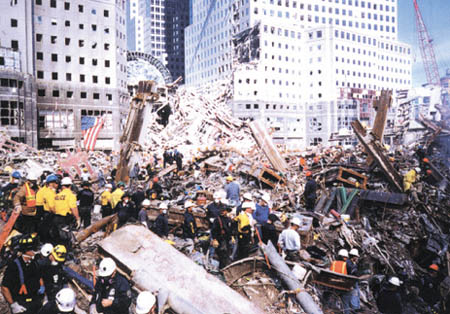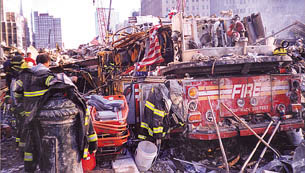Michigan laborer brings home news of Ground Zero 'The union construction presence was awesome'
Date Posted: September 28 2001
The entire nation watched with horror as the events unfolded on the morning of Sept. 11, 2001. For David Nadeau, the terrorist attacks were a call to action.
Nadeau, 41, a member of Laborers Local 334, works for Aristeo Construction, where he is a safety coordinator for the company. He also works as a volunteer firefighter and an emergency medical technician for the Charter Township of Monroe.
A Marine for six years, he put a hold on his regular life from Wednesday, Sept. 13 through Sunday, Sept. 16, to go to New York and help out with the search and rescue effort at the site of the collapsed World Trade Center towers. When he returned to Monroe, he was bone-weary, realized how much he missed his family, and was saddened and angered by what he saw in the rubble.
At the urging of a co-worker, laborer superintendent Wally Mack at the Ford Wixom plant, David contacted our office last week and said he had some photos of the site and a story to tell. Here is his story:"I knew I had to go…"
"I was working at the Wixom plant, and we heard about the first plane going into the World Trade Center, so we turned on a TV. Then we saw the plane go into the second building. I knew I had to do something. Six years in the Marine Corps had a lot to do with that. Marines get their people out no matter what, and so do firefighters. You never ever forget that. I knew I had to go."
At home that evening, David watched television until 1 a.m. to find a telephone number to call to offer his help, and the next morning he was called back and told his services could be used. He told his safety director at Aristeo, Tom Stevenson, about his plan to go to New York, who in turn contacted company owner Joe Aristeo. Aristeo said if Nadeau went to New York, the company would continue to pay his wages. "That was really nice of him, he didn't have to do that," Nadeau said.
Nadeau said it was difficult to leave his girlfriend and two sons, who are five and six. He and fellow Monroe firefighter Bruce Broman took their firefighting gear and headed to New York in Nadeau's Ford F-150. On the way they met up with a sheriff's canine unit from Jackson, and they followed each other. They arrived in the Big Apple about 8:30 Wednesday night.
Into New York.
"Once we crossed the George Washington Bridge, we went through different police blockades and told them who we were and that we had a cadaver dog," Nadeau said. "They sent us down about five blocks to the Port Authority police. We put on our gear, and we started walking to Ground Zero."
There they found a New York Fire Department lieutenant who was looking for EMTs. They went to the nearby American Express building, "where we started digging around a bit, and found a body part, David said. "That was the start." They brought in buckets of debris to a receiving area, where the volunteers found themselves sifting through the debris in the buckets looking for more body parts. The parts were placed in a body bag with a tag indicating the location where they were found.
"You couldn't count the number of body parts we saw," he said. One body part was a liver.
They worked through the night, and Nadeau said he only got two hours of sleep on a cot in a high school. The rest of his time in New York, he slept in his truck.
The first day.
When he first saw the devastation in the light of day, "I couldn't believe it," Nadeau said. "I guess it was the Marine in me. I was just asking myself, 'how could this happen? What events led up to this? How did they get this far? How did they do this?' I'm angry that we trained these people in our country and they used our planes to do this."
Nadeau described "an extremely dangerous" site that Thursday, with shifting piles of rubble and a great deal of uncertainty about the structural integrity of the nearby buildings.
"They told you, 'keep looking up.' There was a steel beam embedded in a nearby building and you never knew if it might fall," he said. "There were no safety rules. I couldn't believe some of the things the iron workers did without a harness. We were climbing that rubble, six, seven, eight stories. Once an acetylene tank fell over, and it just took off across the debris pile like a balloon running out of air. People just scattered. They thought something was going to explode. Everybody was on edge. I was scared too, I admit it."
Under a walk bridge, Nadeau said they found bodies of two police officers in a patrol car, and next to it, several dead firefighters in a fire truck."The New York fire fighters were incredible," Nadeau said. "When we found the body of a firefighter, everything in the area stopped. All the firefighters who were in the area moved in and any part of the body they could find they put in a body bag. If they found his hat, they'd put his hat on top of the bag. When they walked past, everybody stopped and took their hat off and bowed their head. They had total respect for their own."
The union presence.
Nadeau said in the first two days, there wasn't much coordination among the volunteers on the site, and they were getting in each other's way. At one point, when a body was found with a lot of heavy steel around it, a New York Fire Department battalion chief pleaded with the volunteers to step back and let the iron workers do their job to get the steel cut and moved out of the way by operating engineers. He said the union trades took charge of the work, and their efforts were the most important factor in opening up the site to the rest of the volunteers.
"The union construction presence was awesome," Nadeau said. "I salute the people who were there. They're not used to dealing with this stuff, but they did what they could. Iron workers, carpenters, laborers - they all got in there digging on their hands and knees to do the job.
"I'm a laborer, but let me tell you, of all the trades that were out there, everything hinged on the iron workers; they were just incredible," Nadeau said. "They were in there non-stop, cutting steel, sometimes on man-lifts in incredibly dangerous situations. I couldn't believe some of the stuff I saw."
The camaraderie and the conditions.
"The firefighters didn't need to know your name, they just called you brother," Nadeau said. "Every time you'd talk to someone and say you're from Michigan, they'd thank you and say, 'I can' t believe you came this far.' I got a hug from a homicide detective and some other firefighters, who said it's fantastic that you came all the way from Michigan. The people were great."
The City of New York had set up an area in a high school gym where volunteers could get new boots, safety equipment, clothes, even underwear in all sizes - no questions asked. Food was also provided.
"You never once walked down the street without people asking if you need water or anything," Nadeau said. "They were very grateful."
The work was inherently hazardous, but Nadeau said with the exception of an iron worker who broke his leg, he didn't see any volunteers seriously injured. Injuries mostly consisted of cut hands and dust particles in eyes.
At one point, Nadeau said just as he walked past the American Express Building near Ground Zero, the wind picked up and blew out a number of windows, severely cutting some rescuers walking just behind him.
"And the soot and heat coming up from the pile were just awful," Nadeau said. "And later on in the week, there was the stench from the bodies. I heard they figure the dogs who were out there sniffing that dust and the asbestos probably have a life span of about two years."
Lost and (not) found.
A brokerage house statement showing someone with a $55 million account. Family photos. Money. Pens and pencils. A business card for a vice president at Cantor-Fitzgerald, the big brokerage house that lost 600 employees in the tragedy. Those were among the items Nadeau saw in the rubble - but of course, they weren't the focus of the search.
"You always wanted to find somebody alive," he said. "You'd find a pocket in the debris and go into it, and you'd wonder what you'd find going in that hole. You would hope you would find someone alive, but we never did."
Nadeau looked over the shoulder of searchers who probed the debris pile with tiny cameras and microphones in an effort to find signs of life - but none were ever found. They did learn that there were very high readings of carbon dioxide at the bottom of the pile - perhaps from a broken sewer line.
Coming home.
Toward the weekend the organization at the site improved. Military police were guarding checkpoints to keep away the curious. The Federal Emergency Management Agency was bringing a degree of order to the chaos. The feds said that for the time being, they had enough people. Heavy equipment and a mile-long chain of debris-haulers were putting a small dent in the rubble pile.
"I was just exhausted, physically and emotionally," he said. His girlfriend and children wanted him home. So he drove straight back to Michigan, first passing back over the George Washington Bridge, where a huge American flag had been draped. "When I saw that flag, I felt good about what I had done," Nadeau said.
He said he wanted to tell his story not for personal promotion, but to let other Americans know how proud they should be of everyone who volunteered and risked their own health and safety to help others. He said he knew of many other Monroe-area firefighters who went to New York, and saw other volunteers from Michigan while he was there.
On the drive home Sunday, he turned on his car radio and realized how much news he had missed. He had also missed celebrating his youngest son's fifth birthday the day before. Especially on his mind was the degree to which his trip to New York had affected his children.
"They heard on TV about the firefighters, and they got concerned about my safety," he said. "My oldest son asked me if I saw any more bodies there, and he's had trouble sleeping. That tears me apart. I talked to them, and explained that I'm safe, and they're safe. That's just too much for a six-year-old to handle."
Still, Nadeau said he was "lucky" to have had the opportunity to take part in the search effort.
"Would I do it again?" he said. "Yes. Remember what I said about the Marine Corps and the firefighters? They get their people out no matter what."

CONSTRUCTION WORKERS, firefighters, police officers and volunteers from the general public go about the awful business of removing 400,000 tons of rubble that used to be the World Trade Center towers in New York City.

A NEW YORK CITY fire truck is shown smashed by World Trade Center collapse.
Photos by David Nadeau
